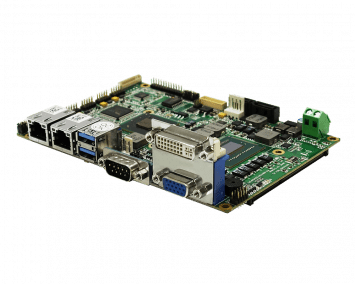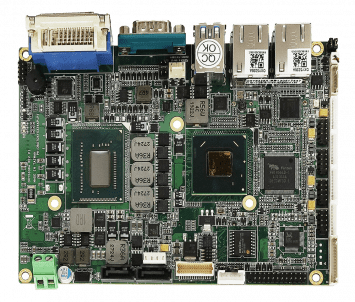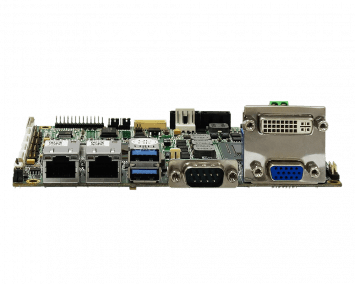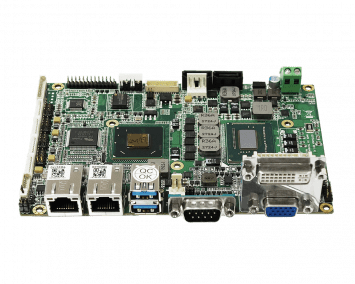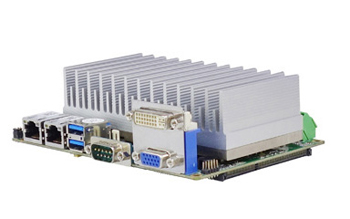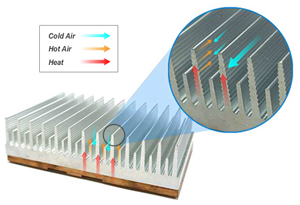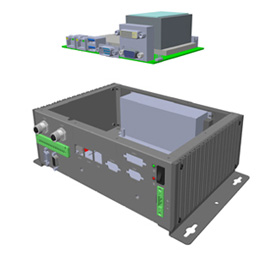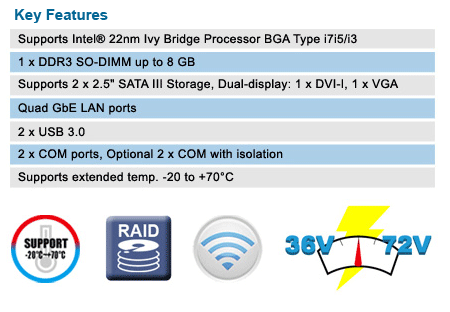OXY5335A
3.5" SBC Intel® Ivy Bridge Processor (Mobile) BGA CPU (i7/i5/i3), Multi-Display by DVI-D, VGA, LVDS, Dual Intel® GbE LAN, +12V DC-in, -40°C to 85°C
- Intel® Ivy Bridge BGA CPU + Intel QM77 PCH
- Multi display: VGA, DVI-I, LVDS
- 4 COM, 10 USB, 2 LAN
- 2 SATAIII and HD Audio
- 1 x Full-size miniPCIe and 1 x mSATA
- Onboard SIM Card slot for 3.5G connectivity
- Extended operating temperature. -40°C to 85°C
- Technical Profile
- Specifications
- CPU
- SSD Performance
- Thermal Solution
Introduction
OXY5335A is a highly integrated 3.5” rugged SBC driven by Intel® 3rd generation Ivy Bridge CPU and chipset soldering onboard. Processor i7-3517UE plus Intel® QM77 chipset supports dual-core ULV 1.7 GHz, consuming only 17W and 4.1W individually. The powerful combination makes the SBC with high computing power for multi-tasking while reducing idle power consumption. Mission-critical applications can take the advantages of processors soldering onboard and extended operating temperature from -40 to 85°C to ensure ultimate durability, utmost resistance to shock & vibration. OXY5335A is truly a rugged SBC ideal for high-end Automation, heavy-duty railway, drilling and energy applications.

Thermal solution for fanless system design
Heat sinks are used to cool down device temperature by dissipating heat into surrounding air. Since the configurations and the power circuit placement of each model are different, which will lead to different extent of heat generation; therefore PERFECTRON designs tailor-made heat sink for each motherboard. Special high and low fin design forms a wind-flow to reduce thermal resistance. Moreover, cross section wave line on the interface increases up to 30-40% air contact area. Combining these two features, thermal performance leverages to utmost. The option of fan is also available to the customers if fanless design is not necessary.
Advanced cooling solution for better heat dissipation
To meet the demands of customer’s extended temperature requirements, the whole thermal solution of OXY5335A simultaneously embraces two heat transfer methods, heat conduction and heat convection. For heat conduction, the solution utilizes a copper heat spreader on the bottom layer which directly contact with the processor and chipset. Heat is then transferred to upper aluminum heat sink. Regarding to heat convection, the temperature differences caused by high and low fin design forms a mild airflow that could bring away heat efficiently. Fan can also be an auxiliary by placing an appropriate sized fan on top of the heat sink. Breakdown drawing is provided as below.
Installation Instruction
Procedure: Stick thermal pad on CPU and chipset, and then simply put passive heat sink on thermal pad.
Copper heat spreader is used to contact with CPU and chipset directly to absorb heat efficiently on the bottom layer, and then spread the collected heat to upper aluminum heat sink. While aluminum is used to force heat convection. After heat spreader transfer heat from bottom layer to heat sink, High and low fin design plus wave line create airflow to dissipate heat.
Aluminum Passive Heat Sink
Heat sink is known for lowering the temperature by dissipating heat into the surrounding air. Though copper absorbs faster, it doesn’t dissipate faster than aluminum.
•It contains 96 % of aluminum, 30.8 mm height and weighs 321 g
•High and low fin design plus wave line increase contact surface up to 30-40% and create airflow.
•Consume shorter heat dissipating time owing to lower metal density
•Better performance in heat dissipating
Copper Flat Heat Spreader
Heat spreader is known for improving the distribution of heat. According to metal characteristics, copper has better heat absorption performance than aluminum. That is why copper is chosen to be heat spreader.
•It contains 99.9 % purity of copper, 5.5 mm height and weighs 326 g
•Absorb heat quicker than aluminum owing to higher heat conductivity coefficient (copper 402: aluminum 266)
•Better performance in heat absorbing
Synergies of copper heat spreader plus aluminum heat sink:
“Copper absorbs heat faster; aluminum dissipates heat faster”
Possessing the physical knowledge and expertise about metal characteristics accomplish the perfect match of thermal solution.
Operating Temp.
Can with stand extended temperature from -40°C to 85°C
|
Operating Temp. |
|
|---|---|
|
-40°C to 85°C |
|
|
System |
|
|
CPU Type |
Intel® Ivy Bridge 22nm Core™ i7/i5/i3 BGA Type Intel® Core™ i7-3517UE (2C x 1.7 GHz), 4M L2 cache (17W) Intel® Core™ i5-3610ME (2C x 2.7 GHz), 3M L2 cache (35W) Intel® Core™ i3-3217UE (2C x 1.66 GHz), 3M L2 cache (17W) |
|
Chipset |
IntelR QM77 Express Chipset (IntelR BD82QM77 PCH) |
|
Memory Type |
1 x 204-pin SO-DIMM DDR3 1333/1600 MHz up to 8 GB |
|
BIOS |
AMI® UEFI BIOS |
|
Watchdog |
1-255 sec. or 1-255 min. software programmable |
|
Expansion Slot |
|
|
Mini PCIe |
1 x miniPCIe for Gen2 |
|
mSATA |
1 x mSATA for Gen2 |
|
Display |
|
|
Chipset |
Intel® HD Grapics 4000 Integrated Graphics Engine |
|
VGA |
Yes (Max. resolution 2048 x 1536 @ 60Hz) |
|
LVDS |
Dual Channel 24-bit LVDS |
|
Display Type |
VGA, LVDS, DVI-I |
|
Audio |
|
|
Codec |
Realtek ALC887 High Definition Audio Codec |
|
Ethernet |
|
|
Chipset |
1 x Intel® 82579LM & 1 x Intel® 82574L GbE LAN |
|
WOL |
Yes |
|
Boot from LAN |
Yes for PXE |
|
Rear I/O |
|
|
VGA |
1 x 15-pin VGA connector (female |
|
DVI-I |
1 x 29-pin DVI-I connector (female) |
|
Ethernet |
2 x RJ45 ports (support 10/100/1000 Mbps for 2 x RJ45 ports) |
|
COM |
1 x RS232/422/485 |
|
|
Serial Signals RS232: DCD-, RXD, TXD, DTR-, GND, DSR-, RTS-, CTS- RS422: TX-, RX+, TX+, RX-, GND RS485: DATA-, DATA+, GND |
|
USB |
2 x USB 3.0 |
|
Internal I/O |
|
|
SATA |
2 x SATAIII (6 Gb/s) |
|
USB |
8 x USB 2.0 ports by pin header |
|
COM |
3 x COM ports COM 1, 3, 4 ports support RS232 by pin header |
|
Audio |
Mic-in, Line-in, Line-out |
|
FAN |
1 x CPU fan |
|
LVDS |
30-pin connector |
|
PS/2 |
1 x 8-pin header |
|
Parellel Port |
2 x 13-pin header |
|
DIO |
8-bit (4 in/4 out) |
|
SIM card holder |
1 |
|
OS support list |
|
|
Windows |
Windows 7 x32、Windows 7 x64 |
|
Linux |
Ubuntu 14.04 |
|
Mechanical and Environment |
|
|
Form Factor |
3.5" SBC |
|
Power Type |
12V DC-in, 4-pin ATX power connector, AT/ATX mode support |
|
Dimension |
146 x 102 mm (5.7" x 4") |
|
Operating Temp. |
-20°C to 70°C |
|
Storage Temp. |
-40°C to 85°C |
|
Relative Humidity |
10% to 90%, non-condensing |
|
TEST STANDARD |
|
|
MIL-STD-810G |
|
|
Temperature Shock |
MIL-STD-810G Test Method 503.5 Temperature Shock Procedure I-C / Storage (Multi-cycle shocks from constant extreme temperature, Form 85℃ to -40℃, Three cycle) |
|
High Temperature |
MIL-STD-810G Test Method 501.5 high Temp ( 96 hours @75℃ non-operating + 72 hours @ 75℃ operating ) |
|
Low Temperature |
MIL-STD-810G Test Method 502.5 Low Temp ( 96 hours @ -40℃ non-operating +72 hours @ -40℃ operating ) |
The OXY5335A offers highly effectively heat conductive and heat convective thermal solutions to meet the demands of customers’ extended temperature requirements. The heat conductive solutions uses an aluminum flat mass to place in direct contact with the processor and chipset, the heat from chips then transfers it to the case of the system. In addition, the convective thermal solutions introduce airflow directed to move across the surface of a fin style heatsink placed on top of the processor and chipset. This can be done with the aid of an appropriately sized fan placed in top of the fin style heatsink. Alternately, enclosure airflow can be routed to flow across a fin style heatsink.
Test Result
| Device Model | OXY5335A | Test Result | Pass | |
| Tester | Ian Huang | |||
| Diagram of curves | Test Temperature | Test Time | ||
 |
High | 0°C to 85°C | 5Hours | |
| Low | -40°C to 0°C | 2Hours | ||
| Test Standard | Reference IEC60068-2 | |||
| Test Software | Burnin test v6.0 | |||
| Criteria | After testing, system can’t halt. | |||
Test Configuration
| Device | Configuration | Manufacturer | Part Number |
| CPU Type | Intel® Core™ i7-3517UE Processor (4M Cache, up to 2.80 GHz) | Intel | i7-3517UE |
| PCH | Mobile Intel® QM77 Express Chipset | Intel | QM77 |
| Memory | Innodisk 8GB DDR3 1600W/T SODIMM | Innodisk | M3S0-4GSSCLPC |
| port2 SATA III | Innodisk 256G SATA III SSD | ||
| port3 SATA II | Apacer SATA III 128GB mSATA | ||
| USB1、USB2 | Passmark Loopback Plugs for USB 3.0 | ||
| LAN1 | Intel® 82574L GbE | Intel | 82574L |
| LAN2 | Intel® 82579LM GbE | Intel | 82579L |
| Test Software | Burnin test v6.0、HD Tune v4.01、iperf、Passmark USB3.0 |
||
| Chamber | KSON THS-b4t-150 Chipeng SMO-3 | KSON Chipeng | THS-b4t-150 SMO-3 |
Thermal Measurement
PERFECTRON provides real lab testing figures to show how CPU performance is with each tailor made thermal kits as important references and design guide for system engineers. For system integration, the crucial challenge is the operation performance under high temperature, thus PERFECTRON conducts long time experiments to make sure the superior testing result for all critical missions. By revealing temperature at processor T junction, processor die and heat sink, PERFECTRON is able to analyse the thermal solution we designed achieves maximum efficacy and observe CPU performance. The high temperature testing takes 5 hours which at each temperature point we burn in OXY5335A-ET-i7-4700EQ for one hour, from 50°C to 85°C.
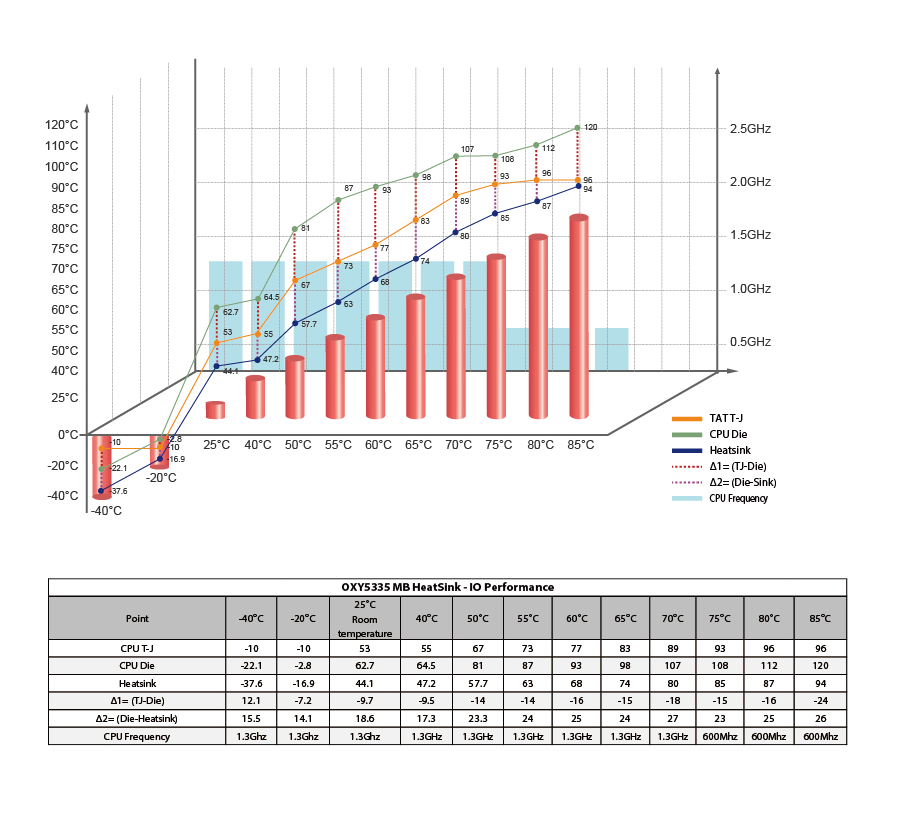

Related System - Railway Computer RC200
PERFECTRON rugged box PCs provides flexible options in terms of processors performance, I/O requirements as well as different industrial applications. The design always comes without fans to ensure silent operation and eliminates the possibility of gathering dust and external debris inflow which may cause system failure over time. Alternatively, PERFECTRON applies advanced conductive thermal design to effectively dissipate the heat outside of the housing. RC200 is a powerful computing model specially designed for event recording in conductor room in railway and in-vehicle applications. It is guaranteed that PERFECTRON rugged box PCs can operate smoothly up to 70°C without CPU throttling.
RC200 main board: 3.5” SBC-OXY5335A
(1) Intel® Core i7 CPU soldering onboard
RC200 is based on 3.5” SBC—OXY5335A, powered by Intel Ivy Bridge i7-3517UE dual core processor plus QM77 chipset soldered onboard. With CPU soldering onboard, there is less conduction of heat and high density interconnection between the motherboard and the component, which reduces the MB from the crisis of overheating. Apart from overheating, soldering onboard also provides the best level of shock and vibration protection, removing the unnecessary concern about poor connection that CPU socket type may bring.
(2) Wide Range DC input
For military and heavy duty vehicle applications, instable voltage always brings headaches about damaging the electric components. RC200 supports 36V to 72V DC-in (default 48V DC-in), the flexible acceptance of inconsistent power input makes it capable of surviving tough engine cranks and transient over-voltage situations. This feature is compliant with EN50155 which is perfectly designed for railway applications.
(3) 4 x Ethernets (2 by M12, 2 by RJ45) & expandable isolated COM ports
For train recording usage, device interfaces are mostly go from LAN ports and COM ports. To add two more Ethernet ports, RC200 adds on LAN card by mPCIe interface, which is developed by PERFECTRON—MT321. Sufficient 10/100/1000 mbps Ethernet connections enable to install more complete surveillance system in vehicle as well as build up interconnection to manage carriage-to-carriage communications, which effectively increase efficiency and safety. It is noteworthy that two out of four connections apply locking M12 connectors to minimize the chance of disconnection caused by shock & vibration during the railway journey. For more I/O support, RC200 provides total 4 COM ports, optional 2 COM ports with isolation. With isolation function, it can provide secured power protection from sudden power surge damaging the controller.
(4) Three-stage thermal design
For military and transport applications, the environment is always harsh and the ambient temperature is varying along with the moving path. Therefore the importance of extended operating temperature is undoubted. PERFECTRON experts create the system design which involves three-stage thermal design which allows RC200 to survive from -20°C to 70°C. The thermal solution flexibly maximize the metal characteristic, using copper heat spreader to absorb heat directly from heat sources, then using heat pipe to transfer heat to aluminum heat sink. The copper heat pipe is the key factor among the whole thermal design. The heat conductivity coefficient of heat pipe can be up to 5000, nearly 12 times better than copper heat spreader. With a perfect combination of copper plus aluminum thermal kit which efficiently manage the heat dissipation up to 70°C.
Advanced cooling solution for better heat dissipation
To meet the demands of customer’s extended temperature requirements, the whole thermal solution of OXY5335A simultaneously embraces two heat transfer methods, heat conduction and heat convection. For heat conduction, the solution utilizes a copper heat spreader on the bottom layer which directly contact with the processor and chipset. Heat is then transferred to upper aluminum heat sink. Regarding to heat convection, the temperature differences caused by high and low fin design forms a mild airflow that could bring away heat efficiently. Fan can also be an auxiliary by placing an appropriate sized fan on top of the heat sink. Breakdown drawing is provided as below.
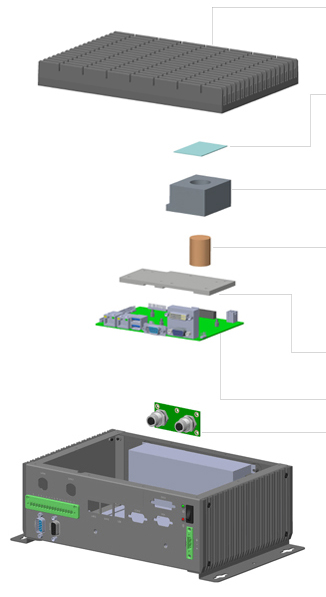
Aluminum Housing
- 96 % of aluminum, 30.8 mm height and weighs 2.112 kg
- Nickle plated to prevent corrosion and rust
- Robust design to withstand shock, vibration and strike
Thermal Pad
After countless of experiments, PERFECTRON engineers learned valuable lesson about the best thickness of thermal pad from failures.
Precision design of thermal pad: gap between CPU die and heat sink should less than 1mm
Aluminum Heat Sink
96 % of aluminum, 32.6 mm height and weighs 270 g
Copper Heat Pipe
Heat pipe transfers heat from the heat sources to the heat sink over relatively long distance. Two-phase heat transfer involves the liquid-vapor phase change of a working fluid.
- 5.0 mm width diameter, 56-61% purity of copper and weighs 0.87g
- High heat conductivity coefficient up to 5000
Copper Heat Spreader
99.9 % purity of copper, 6.7 mm height and weigh 360 g
OXY5335A
MT321
- Intel® i210IT Mini PCIe Dual Gigabit Ethernet Network module
- 2 x 10/100/1000 Mbps LAN ports
- mPCIe interface
- Intel® i210IT chipset
- Available with M12 connector or RJ45 connector
Superb Graphic Performance and High Speed Data Management at Low Power Consumption
The OXY5335A uses onboard BGA type processors, offering Intel Core i3 3217UE (2C x 1.6GHz, 17W), Core i5 3610ME (2C x 2.7GHz, 35W), and Core i7 3517UE (2C x 1.6GHz, 17W) processors and supporting SO-DIMM DDR3 1333 MHz for up to 8 GB memory, all while measuring a mere 146mm x 102mm (5.7” x 4”) in size. With the exception of PERFECTRON’s wide temperature design range of -20 to 70°C (-40 to 85°C optional), it features a rich array of I/O interfaces and extensions, with two gigabit Ethernet ports by RJ45, multi-display VGA, DVI, 18/24-bit dual-channel LVDS interfaces, two USB 3.0 ports on the Rear I/O and eight USB 2.0 ports by the pin header, one COM for the RS232/422/485, three other COMs for RS232 by the pin header, two SATAIII( 6Gb/s), one Mini PCIe, one mSATA, 8-bit DIO (4 in/4 out), and one parallel port on board by the pin header. Its uses 12V DC-in power supplied by a 4-pin ATX power connector through an AT / ATX mode, optional for Terminal Block power connector.
